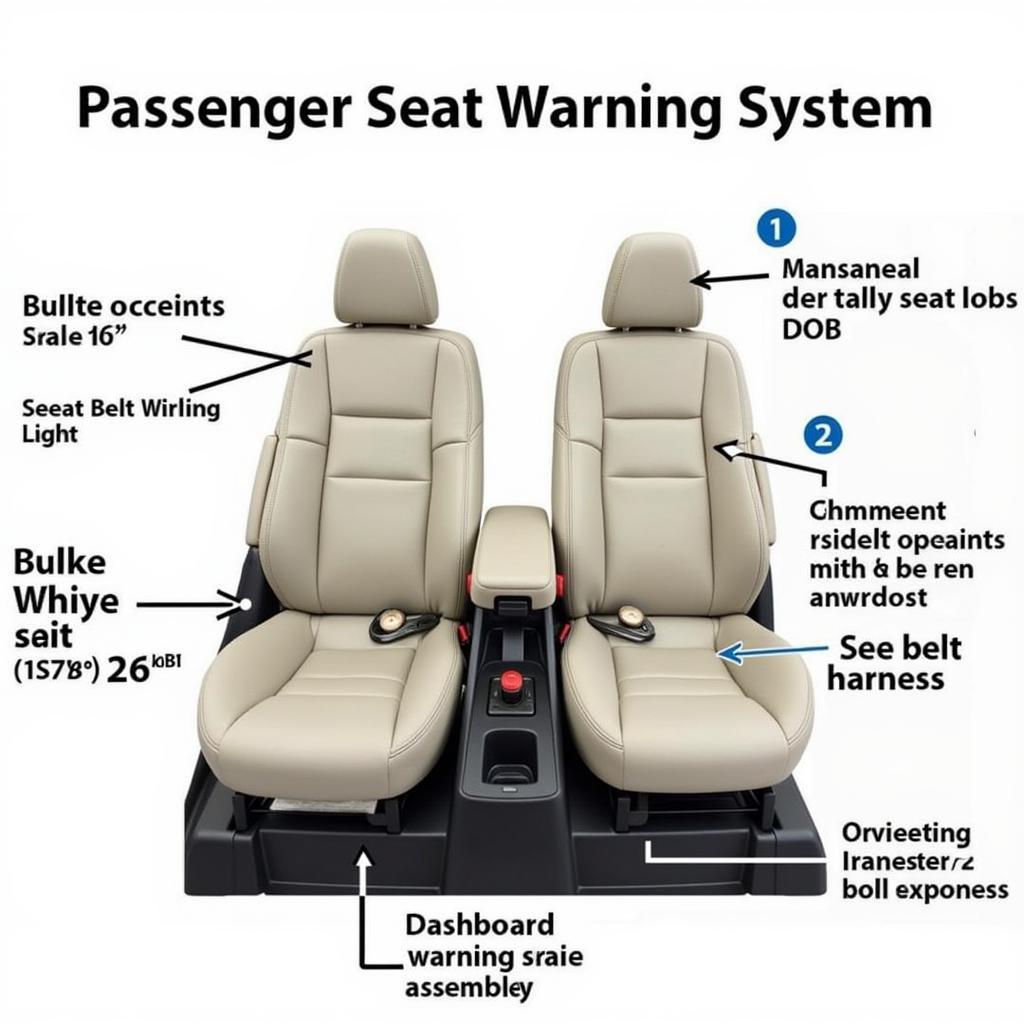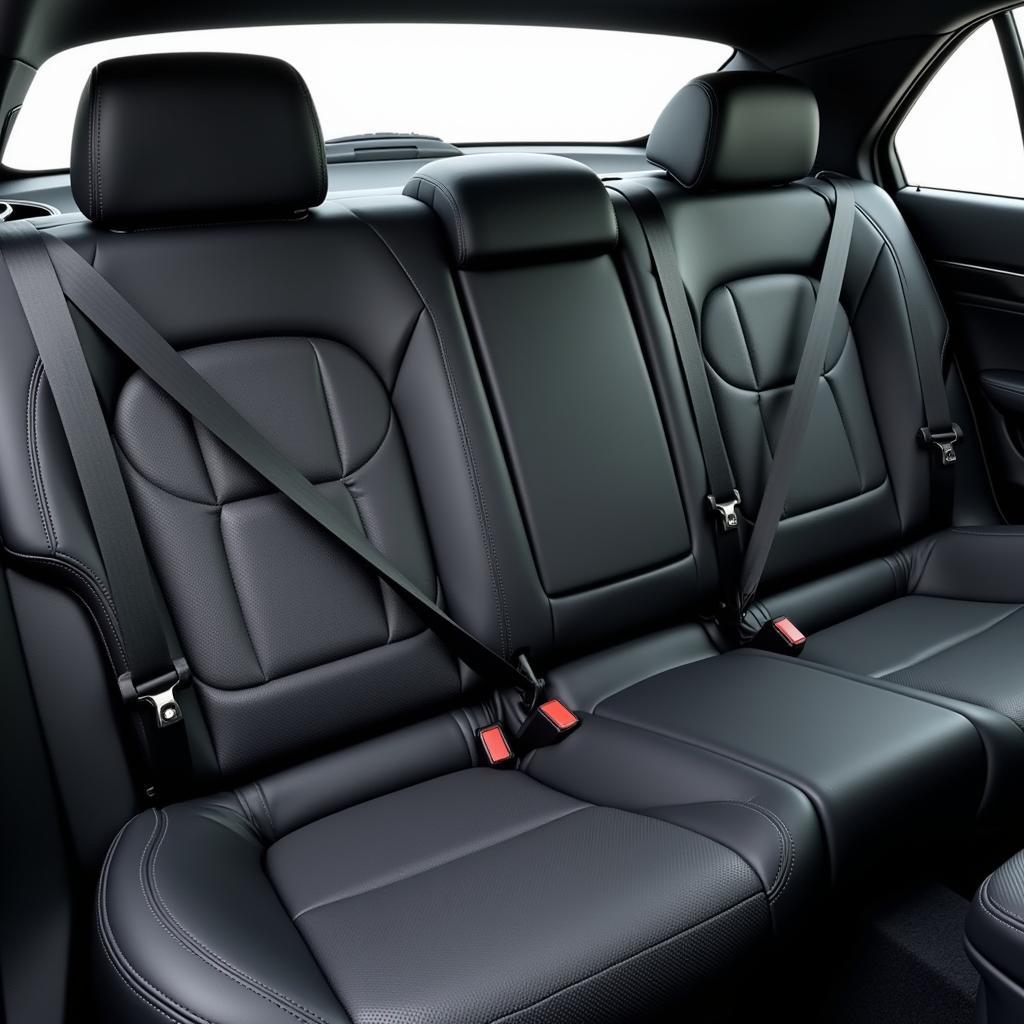The dreaded passenger seat belt warning in your BMW can be a nuisance. This guide will delve into the common causes and offer practical solutions to help you fix BMW passenger seat belt warning issues, whether it’s a faulty sensor, wiring problem, or software glitch. We’ll cover everything from simple checks you can do yourself to more advanced diagnostic techniques. Let’s get started and silence that annoying chime!
If your BMW is displaying a passenger seat belt warning even when the seat is unoccupied, there are several potential reasons. Check out our detailed guide on bmw passenger seat belt warning for more information.
Understanding the BMW Passenger Seat Belt Warning System
The seat belt warning system in your BMW is designed to enhance safety. It uses sensors in the seat to detect the presence of a passenger and whether the seat belt is fastened. When the system detects a passenger but not a fastened seat belt, it triggers a visual warning on the dashboard and an audible chime. Understanding how this system works is crucial to diagnosing and fixing any issues.
Common Causes of BMW Passenger Seat Belt Warnings
Several factors can trigger a false passenger seat belt warning. Here are the most frequent culprits:
- Faulty Seat Occupancy Sensor (SOS): This sensor, located within the passenger seat, detects weight and pressure. If it malfunctions, it can incorrectly signal the presence of a passenger, even when the seat is empty.
- Wiring Issues: Damaged or corroded wiring connected to the SOS can disrupt the signal and cause a false warning.
- Software Glitches: Sometimes, a software bug within the car’s computer system can cause the seat belt warning to malfunction.
- Seat Belt Buckle Malfunction: Though less common, a faulty seat belt buckle can also trigger the warning.
After trying basic troubleshooting steps, you might need to look into specific model issues, such as the 2010 bmw 328i seat belt disable warning, for more targeted solutions.
Diagnosing the Problem
Before attempting any fixes, it’s essential to pinpoint the exact cause of the warning. Here’s a step-by-step approach:
- Visual Inspection: Start by visually inspecting the seat belt buckle and the wiring underneath the passenger seat. Look for any signs of damage, wear, or disconnection.
- Check the Owner’s Manual: Your BMW’s owner’s manual can provide valuable information specific to your model.
- Diagnostic Tools: Using a BMW-specific diagnostic scanner can help read error codes stored in the car’s computer, providing more precise insights into the issue.
 BMW Passenger Seat Belt Warning System Components
BMW Passenger Seat Belt Warning System Components
DIY Fixes for BMW Passenger Seat Belt Warning
Depending on the cause, you may be able to fix the issue yourself. Here are some potential solutions:
- Seat Belt Buckle Cleaning: Try cleaning the seat belt buckle with compressed air or a specialized contact cleaner. Debris or corrosion can sometimes interfere with the buckle’s connection.
- Wiring Check and Repair: If you have experience with car wiring, carefully inspect the wiring under the passenger seat. Repair any damaged or corroded wires.
- Software Update: Check for available software updates for your BMW’s control modules. Sometimes, software updates address known bugs that can cause the seat belt warning to malfunction.
If you’re experiencing issues with other warning lights, such as the passenger seat airbag warning, it’s important to address them promptly to ensure the safety of your vehicle.
When to Seek Professional Help
While some fixes can be done at home, more complex issues require professional assistance. If you’re uncomfortable working with car electronics or haven’t been able to resolve the issue with the DIY methods, it’s best to consult a qualified BMW technician. They have the expertise and specialized tools to diagnose and repair the problem correctly.
It’s crucial to understand how the seat belt warning light works to effectively diagnose and troubleshoot any related issues.
Preventing Future Issues
Regular maintenance and inspections can help prevent future problems with your BMW’s seat belt warning system. Here are some preventative measures:
- Keep the Interior Clean: Regularly clean the passenger seat and surrounding area to prevent debris from interfering with the sensors.
- Regular Inspections: During routine maintenance, ask your technician to check the seat belt system, including the sensors and wiring.
“Regularly inspecting and cleaning your car’s seat belt system can prevent many common issues,” advises John Smith, Senior Automotive Technician at Bavarian Auto Experts. “This simple step can save you time and money in the long run.”
Conclusion
Fixing a BMW passenger seat belt warning requires a systematic approach. By understanding the system, identifying the potential causes, and following the diagnostic steps, you can effectively address this issue. Remember to prioritize safety and consult a professional if you encounter any complexities. Addressing the BMW passenger seat belt warning promptly not only silences the annoying chime but also ensures the proper functioning of your car’s safety systems.
 BMW Passenger Seat with Seat Belt Fastened
BMW Passenger Seat with Seat Belt Fastened
You can even customize your car’s alerts. Learn more about downloading custom sounds at bmw seat belt warning sound download.
“Using a diagnostic tool can quickly pinpoint the problem, saving you the hassle of guesswork,” adds Maria Garcia, Lead Diagnostic Technician at Ultimate BMW Repair. “This targeted approach ensures efficient and accurate repairs.”
FAQ
- Can I disable the passenger seat belt warning? Disabling safety features is generally discouraged as it compromises passenger safety.
- How much does it cost to replace a seat occupancy sensor? The cost varies depending on the BMW model and labor rates.
- What if the warning persists after replacing the sensor? Further diagnostics may be needed to identify other potential issues like wiring problems.
- Can a software update fix the problem? Yes, in some cases, a software update can resolve software-related glitches causing the warning.
- Is it safe to drive with the passenger seat belt warning on? While the car is still drivable, it indicates a potential issue with the safety system that should be addressed.
- How often should I have my seat belt system inspected? It’s recommended to have it checked during routine maintenance.
- Can I use aftermarket seat occupancy sensors? Using OEM parts is generally recommended for optimal performance and compatibility.

